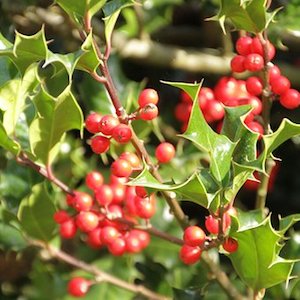
The Holly and the Ivy – when they are both full Known …
HOLLY at Christmas
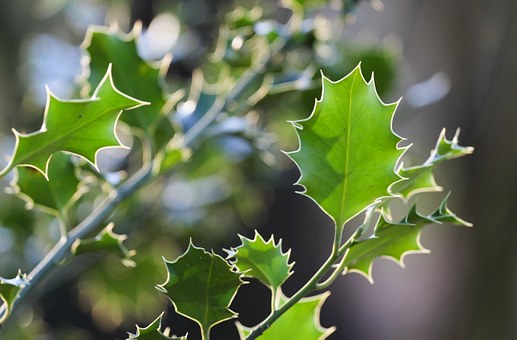
Prickly Christmas Trees
We’re familiar now with the idea that our Nordic Christmas trees were introduced in Victorian times, before then, reference a ‘Christmas tree’ and you’d be talking about the Holly tree. Some homes will still prefer a holly branch to a Christmas tree.
In the Chilterns there’s a place called Christmas Common, where holly trees grew in abundance, acknowledging the old association.
Local names for the holly tree include ‘prickly Christmas’ and ‘Christ’s thorn’. Medieval monks called it the Holy Tree.
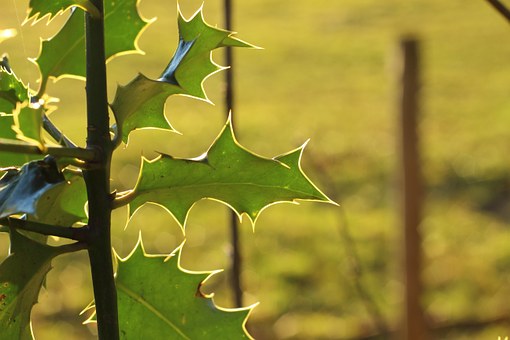
Longstanding luck
A constant in our landscape, there are many thoughts as to why the holly is so well regarded and left to grow while other hedgerows plants are grubbed out.
The practical suggest that the evergreen tree provided line of sight for ploughmen.
Or possibly, it’s longevity is because it is not much troubled by insects; the thick, waxy leaves are so impenetrable it plays host to possibly the lowest diversity of mini-beasts of any hedgerow species.
The superstitious believe that when a holly goes a witch appears in its place; or they fear illness, heartbreak or disaster precipitated by cutting down a holly.
There’s also a tradition that holly is the ‘King’s’ tree and therefore not to be cut down, which perhaps explains the line in the carol ‘Of all the trees that are in the wood, the holly wears the crown’.
Deck the halls
Gathering boughs laden with berries to decorate homes is a classic Christmas tradition. It is believed that elves and fairies will join your Christmas celebrations if they have a holly branch to shelter under, and in return they’ll protect you from the house goblin. It is unlucky, however, to bring holly into the house before Christmas Eve.
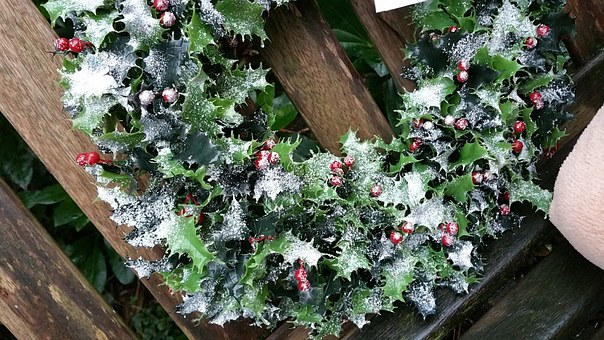
If you’re bringing holly indoors to decorate your home this year, you might like to consider carefully how you do so, and especially how you dispose of it afterwards, it seems there are many, sometimes contradictory, options:
– in Yorkshire a leaf from the holly decoration was taken and placed in every room in the house
– in Lancashire if a holly leaf fell from a decoration it should never be put on the fire
– in Hampshire holly used in decorations should be burnt in the garden afterwards for continual good luck throughout the year
– in Shropshire, a sprig of holly from the Christmas decorations was left until Shrove Tuesday when it was then taken down and put on the fire over which the first pancake was cooked
– in Scotland they encouraged boys to thrash each other with the holly as decorations were taken down: every drop of blood drawn added a year to the boy’s life
there are some special precautions for those in Somerset:
– if you only have holly without berries, then include a sprig of box in your arrangement too to counter the ill luck non-berried holly could bring
– if you have berried holly, it should only be brought indoors by a man
She-holly and He-holly
For decorating, the top most branches of a holly tree were prized and could command a higher price. Why? because above browsing height you could find less prickly leaves, known as ‘free’ or ‘slike’ holly.
This non-pricky holly was also sometimes called he-holly; in contrast to the prickly she-holly.
In Derbyshire it was said that if prickly holly was used in the Christmas decorations, the man would be master for the following year, but if non-prickly, the woman would reign.
 He-Holly
He-Holly 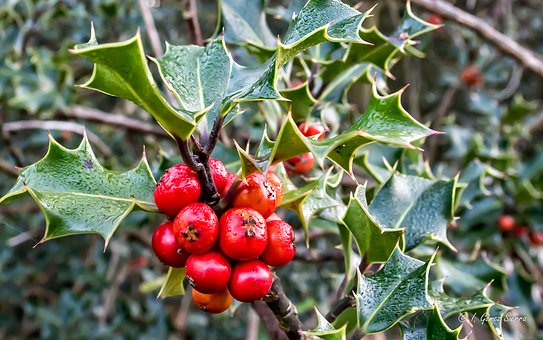 She-Holly
She-Holly
You can also put a smooth-leaved holly under your pillow for the divination of dreams. In the language of flowers, holly stands for foresight and good wishes.
Nutritious fodder
Less prickle would be advantageous when holly is used as fodder. It’s been winter food for sheep since ancient times as it has one of the highest calorific contents of all the trees animals browse and it’s rich in nutrients too. Sometimes leaves were ground to make them more palatable.
Rudimentary shelter
Holly is known to provide shade in summer and shelter in winter (it takes a while for rain to penetrate the canopy). A true gypsy woman would always give birth under a holly tree, and cattle too will seek one to calve under. Which seems another appropriate connection at this time of year as we celebrate a special birth in rather rudimentary conditions.

Holy holly
The name holly may be a corruption of ‘holy’ suggesting a connection with the Christ Child, probably due to the adoption of holly as part of the Christmas celebrations borrowing from the Roman Saturnalia December festival of merrymaking.
Holly is also turned to at the other end of life, a sprig should be hung up high in a new building or in one where an animal has died in order to remove and keep away evil spirits. Remember to burn it when you take it down.

IVY at Christmas
Cheerful companion
Since the depiction of Baccus crowned with a wreath of ivy and vine leaves, ivy has been a companion of drink (Bacchus was hidden under an ivy bush by his mother when he was a boy).

Ivy-covered poles were used to advertise taverns in Medieval times, known as ‘ale stakes’. The competition between inn-keepers led to taller and taller stakes being used until in 1375 an Act of Parliament was passed to restrict their height to seven feet.
Its association with drink has led to ivy being banned from decorations in some churches, however there are carvings of ivy in both Westminster Abbey and Wells Cathedral.

Hangover cure
Ivy was once thought to overcome the effects of alcohol, probably because it could smother grape vines.
– – Those who’ve had too much wine are supposed to be able to cure their hangover by drinking a further pint of wine, this time boiled with bruised ivy leaves.
– – Pliny said taking yellow ivy berries beforehand can prevent drunkenness. (Culpeper tells us ivy berries are not ripe until they have felt the winter frost).
Cato reckoned that wine put into a cup made of ivy would run through it, such was the antipathy between the two.
Ivy ale
Ground ivy was used to clarify and flavour ale before hops became more common; it also improved the ale’s keeping qualities.
Alongside it’s many other medicinal uses, ground ivy is said to cheer away melancholy.
Ivy cures
There are far more folk remedies that make use of ivy leaves than holly. They’ve been applied to cradle cap, to burns minimising scarring, to warts and corns and in ointments or infusions for sunburn or sore eyes.
Some remedies that may come in handy over Christmas:
– for a stomach ache, boil ivy leaves in vinegar and press onto your side
– for a headache, boil ivy leaves in rosewater and apply to the temples
Although not typically eaten by animals, they seem to know to eat ivy when they are sick, suggesting it has medicinal properties for them. If nanny goats eat ivy, it taints the milk.
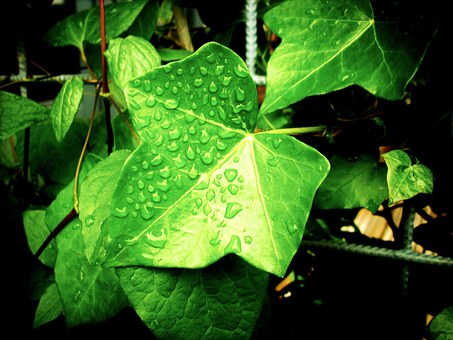
Ivy honey
Ivy provides the last main source of nectar for bees top up their winter stores. Honey made from ivy honey is sometimes known as ‘winter honey’ it has a distinctively rich flavour and firm texture.
Ivy in skincare
In skincare ivy is also associated with firmness, being a recommended addition to massage oil to combat cellulite.
Make your mince pies using an ivy pin
Ivy was traditionally used to make rolling pins. It’s heartwood is a glossy cream colour and dries to the texture of ivory, so pastry doesn’t stick to it as much as other wood.
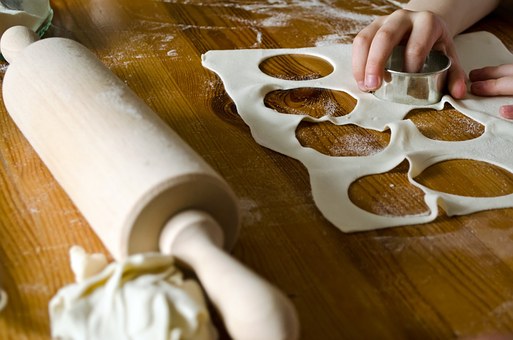
Ivy was used to make clothes last longer too – boiled up in water they could restore colour to dark clothes, or by ironing through a damp cloth wrung out in a solution of boiled water and ivy leaves the shine could be taken off over-worn suits.
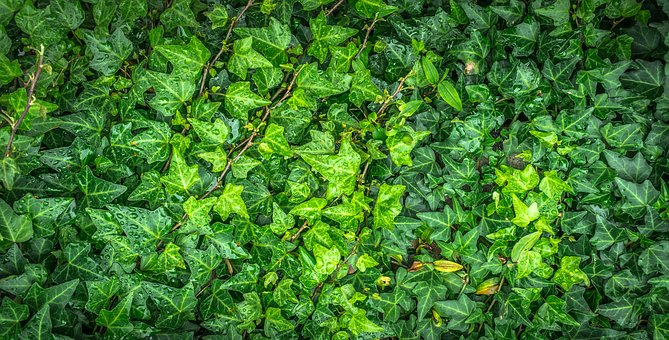
Ivy traditions
Of course there are seasonal traditions around ivy too:
– – Feed an ivy leaf to every animal before 12 o’clock on Christmas day and that will keep the Devil away for 12 months
– – Leave an ivy leaf on a dish of water on New Year’s Eve and don’t touch it until January 6th. If you then find it fresh and green, the year will be happy; if there are black spots, there may be illness; if withered, beware of death.
– – Wearing an ivy leaf is supposed to prevent a child being pinched by another child (handy if your family is a fine of giving ‘a pinch and a punch, for the first of the month’). Btw, if you are pinched while carrying an ivy leave, you earn the right to pinch back 12 times.

And, just because it’s Christmas … here are a couple of cracker jokes
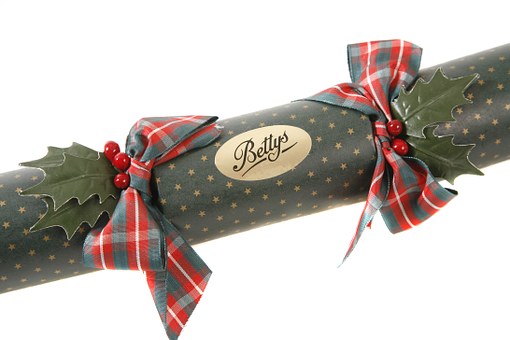
What did the Roman Emperor call his fourth daughter? IV
Knock, knock
Who’s there?
Holly
Holly who?
Hollydays are here again

